Roller Skating Promotes the Physical Health of Children and Adolescents: Meta Analysis
Introduction
Today, the pace of modern life is accelerating. A sedentary lifestyle combined with a lack of physical activity is becoming an increasingly serious health problem, especially for children and adolescents. Due to lack of interest in physical exercise, most children and adolescents in China have little time for physical exercise and cannot form good exercise habits. The 19th National Congress of the Communist Party of China made a major decisionmaking arrangement for the implementation of a healthy China action strategy, emphasizing adherence to prevention, advocating a healthy and civilized lifestyle, and preventing and controlling major diseases. Promote the change from treating the disease as the center to people’s health as the center and clearly raise the concerns about the physical and mental health of young people. A number of cross-sectional surveys by the American College of Sports Medicine (ACSM) found that the incidence of obesity among children and adolescents aged 2-19 years is as high as 4—17% [1], And found that the obesity rate of children and adolescents in Asia in recent years has also shown a rapid upward trend, leading to the early stage of various chronic diseases, directly threatening the physical and mental health problems of children and adolescents. Research discussion. As an important part of ensuring a healthy life, sports not only promotes health and improves the body’s ability to resist diseases, but also regulates people’s psychological activities toward health [2].
In recent years, roller skating has been favored by the majority of children and adolescents. Some studies have shown that roller skating can fully exercise the muscular system and small joints, thereby playing a good role in the balanced development of various parts of the body [3-4]. Roller skating exercises have high requirements on the muscle strength and endurance of the participants’ upper and lower limbs, waist and abdomen, as well as the flexibility of the hips and hips [5]. Through principal component analysis in many experimental studies, the main physiological factors that affect roller sports and the strength, aerobic capacity and body fat percentage of roller skating training are clearly identified.However, the systematic review and meta-analysis of the effect of roller-skating on the improvement of children and adolescents’ physical health has not been valuable research. Therefore, it is necessary to use the meta analysis method to extract and combine the research results presented, to prove the reliability of the research results.
Method
Search Strategy
According to the PICO model, the subject terms of the research content are graded. This study uses “roller skating”, “children”, “teenagers”, “impact”, “rollerskating”, “child”, “minors”, and “adolescent” as the subject words. Use the combination of subject words and free words, supplemented by literature tracking. The subject words and free words of the research were searched, screened and determined in the CBM, Pubmed and Weipu databases. Relevant Chinese and foreign language documents are searched through the Chinese literature search platform of China HowNet, Wanfang and Weipu Journals and the Web of Science, Pubmed, psycINFO, and SPORTDiscus foreign language databases. The search period is from December 31, 2019.On the basis of strict paper retrieval requirements and publication time, the papers that meet the research conditions are imported into the literature reading and management software, and the human-machine combination screening is performed on the document titles, abstracts and fulltext reading methods. The retrieval process is shown in (Figure 1).
Study Selection
The meta-analysis-based literature incorporation is based on the PICOS method of evidence-based medicine, which mainly considers the five factors of participants, interventions, control groups, research results and research design to determine the inclusion criteria for the basic situation of literature in related fields:
1. The research subjects are healthy and well-developed children and adolescents without organic lesions and obvious physiological defects, regardless of gender
2. Comply with the requirements of parallel trials of randomized controlled studies and non-simultaneous controlled trials of non-randomized controlled studies
3. The result measurement index is the content of 3 dimensions of physical fitness
4. Whether the test is blind or not
5. The intervention time is not less than 4 weeks.
Determine the criteria for excluding literature based on “Systematic Review and Meta-Analysis Priority Report Entry: PRISMA Statement” [6]:
1. Duplicate literature
2. System review, conference report, meta analysis
3. Research content does not match, no data literature
4. Experimental method design is not rigorous, the outcome index gap is large, and RevMan5.3 software is used to draw the literature process Figure.
Data Extraction
In order to ensure the quality of the first time the literature is included, the literature search, screening, and data extraction are arranged by two researchers. If the statistical results and opinions are different, the third party’s suggestions are listened to and adopted. The basic characteristics of the included literature mainly include: first author, year of publication, age of subjects, sample size of EG and CG groups, intervention plan design and test index data.
Quality Evaluation
A randomized controlled trial Cochrane risk bias assessment tool [7] was used to evaluate the quality of the included literature. The quality assessment mainly includes the following 7 aspects: random allocation method, concealment of allocation scheme, blind method, blind method of result evaluation, completeness of result data, selective reporting of research results, and other sources of bias. A total of 7 points, satisfying a score of 1 point, classify the quality evaluation statistical results: satisfying 6 points or more is a low degree of bias risk; 4-5 points are moderately biased risk, and 3 points or less are highly biased risk.
Statistical Analysis
According to the meta-analysis scientific method to summarize the classification requirements of the effect quantity, the Q test or I2 test is used to evaluate the heterogeneity. When the result of the Q test indicates that the heterogeneity is significant (I2≥50%), the random effect model is used, otherwise the fixed Combination and calculation of effect model data . If the heterogeneity is too large, use descriptive analysis. In order to ensure the heterogeneity test of the extracted data, it is necessary to select at least the data obtained from the two groups of experiments in the pre-test and post-test to calculate the effect amount of the test data [8], Calculate the effect size of the selected variable and generate a forest map [9]. A positive ES value indicates that the intervention effect is good, and a negative value indicates that the intervention effect is not good. Usually, researchers defifine ES as small (0.2< ES < 0.4), medium or moderate (0.4< ES < 0.6) and large (ES ≥0.6) with p < 0.05 [10]. The data in this study were continuous variables, and the effects were expressed as standardized mean difference (SMD) or standard deviation (MD), and a 95% confidence interval was calculated. The heterogeneity test between the studies used the consistency coefficient I2 and P test, P<0.1, I2≥50%, using RevMan5.3 software to analyze and merge the amount of research included [11].
Results
Study Selection
83 articles were retrieved through database search. After repeated literature elimination, title reading and abstract screening to exclude non-RCT, rigorous experimental design and unsuccessful research data, 16 articles were finally included, including 14 Chinese literature and 2 English literature. A total of 1296 experimental participants 9 (Table 1).
Characteristics of the Exercise Interventions
The literature inclusion criteria and exclusion criteria included a total of 16 research literatures, recording the study characteristics of the author, the year of publication of the article, the type of study, the frequency and duration of intervention. All included studies reflect the effects of roller skating on children and adolescents in terms of their body shape, physiological function, physical fitness and adaptability. The most frequently used evaluation indicators: balance ability and explosive force, are used to measure the changes in neuromuscular control of movement after participating in roller skating; second evaluation indicators include speed, endurance, sensitivity, flexibility, vital capacity, and social adaptation. In the 16 articles included in this study, a total of 1296 participants of a gender mixed age range of 4-21 years and expected to range from 8 weeks to 36 weeks. There are large differences in the intervention programs among the studies. The duration of a single intervention ranged from 15 to 120 minutes, and most of them concentrated on 30 to 60 minutes. The frequency of interventions ranged from 1 to 7 times per week, and the intervention cycles also varied greatly. The shortest cycle was 8 weeks and the longest cycle was 36 weeks. (Table 2) lists the basic characteristics of each study.
Table 2: Summary of the observed data from the included studies (n=1296).
Note: Abbreviations: F=female; EG=experimental group; CG=control group; ①Balance ability, ②Flexibility, ③Sensitivity, ④Lower limb strength, ⑤Speed quality, ⑥endurance, ⑦Body Height, ⑧Vital capacity, ⑨Social Adaptabilit
Methodological Quality and Risk Assessment of Bias
Using the Cochrane risk bias assessment tool of the randomized controlled trial, the evaluation results of the included 16 literatures showed that there were 1 low-risk literature, 14 medium-risk literature, and 1 high-risk literature [12]. In (Figure 2), “+” means compliance, “-” means failure, and “?” means that the text has not been described in detail; Figure 3 is a statistical chart of the proportion of each item of methodological assessment (Figure 4).
Figure 4h: Relationship between roller skating and the social adaptability of children and adolescents.
Meta Analysis Results
The full text reading of the 16 included documents shows that the focus of the study on the effect of roller skating on the improvement of children and adolescents’ physical health is different. The performance of the same indicator uses different test methods, and some research subjects have different genders. A comprehensive analysis of the 9 indicators identified in the 16 literatures uses independent analysis of each indicator to analyze the effect size heterogeneity and research publication bias. The results are as follows.
Balance Ability: Meta-analysis of the balance ability of children and adolescents to include 17 sets of test data from 11 studies involving 960 participants [13-23]. Including 4 sets of independent men and women, 2 sets of dynamic and non-dynamic balance ability test data [14-17,22-23].After the heterogeneity test, I2=93%, and Q test P<0.1, suggesting that there is strong heterogeneity between the selected literatures in this study, and random effects can be selected for meta analysis. The data from this study highly suspected that the source of heterogeneity was inconsistent test methods. Random effects meta-analysis results showed that the experimental group’s balance ability was improved by 1.29, Z=4.62, P<0.01, indicating that roller skating has a positive effect on improving the balance ability of children and adolescents.
Lower Limb Pedaling Power: The meta-analysis of the strength and quality of children and adolescents is based on the seven studies and 17 sets of test data, involving 502 participants [13,16-17,19-21,23-24], Including 3 independent test data for men and women. After heterogeneity test, I2=78%, and Q test P<0.1, suggesting that there is strong heterogeneity between the selected literatures in this study, and random effects were selected for metaanalysis. Through the data of this study, it is highly suspected that the source of heterogeneity is the inconsistency of strength evaluation methods and test methods. Random effects meta-analysis results show that Z=2.65, P<0.01, there is a significant difference between the experimental group and the control group, which shows that roller skating can improve the strength and quality of children and adolescents.
Body Height: Meta-analysis data on the effect of roller skating on the height of children and adolescents comes from 9 sets of data involving 866 participants [16,19,23-26],Including 3 sets of independent data sets for men and women [16,24,26]. The height data of the experimental group and the control group increased after exercise intervention testing. The total SMD value was 0.13, the 95% confidence interval was [-0.01, 0.27], Z=1.79, P>0.05, the data was not statistically significant.
Flexibility: For the study of roller skating to improve the flexibility of children and adolescents, analysis of 6 included literatures and 9 groups of balance ability test data, involving 771 participants [13,17,21-25], Includes 6 independent test data for male and female [13,17,23]. Heterogeneity test I2=87%, and Q test P<0.1, suggesting that there is strong heterogeneity between the selected literatures in this study, random effects are selected for meta analysis; 2 articles are left out in the sensitive analysis process and the remaining 4 articles. There is no heterogeneity, I2=0%, and Q test P>0.1, then the fixed effect combined effect amount is used. The results showed that the flexibility of the experimental group was increased by 0.05 compared with the control group, but the results were not statistically significant P=0.52>0.01, indicating that the effect of roller skating on the flexibility of children and adolescents is not obvious.
Speed Quality: A meta-analysis of the effect of roller skating on children and adolescents’ speed and quality. The data comes from 8 sets of data involving 810 participants in 5 studies [13,17,23-25], three separate data sets for male and female students [17,23,25]. After exercise intervention, the speed quality of the experimental group and the control group improved (95%CI, 0.14-0.20), Z=11.62, P<0.01, indicating that roller skating can improve the speed ability of children and adolescents.
Sensitive Quality: Meta-analysis data on the relationship between roller skating and children’s and adolescents’ sensitive qualities came from 5 studies involving 6 sets of data from 276 participants [13,16,18,19,21], Including 1 group of independent data set of male and female [17]. The total SMD value is 0.64, and the 95% confidence interval is [-1.13,2.41], Z=0.71, P=0.48>0.05. Studies have shown that the effect of roller skating on the sensitivity of children and adolescents is not significant.
Vital Capacity: The meta-analysis data of the relationship between roller skating and the vital capacity of children and adolescents comes from 9 groups of data involving 770 participants from 5 studies [16,17,24-26], two independent data sets of 3 groups of male and female were included [16-17,26]. After the heterogeneity test I2=99% and Q test P<0.1, it indicates that the included literature has strong heterogeneity, and the random effect of the combined effect size is selected. Based on the overall study of the included literature, it is highly suspected that the heterogeneity source test method is inconsistent. The results showed that the total SMD value was 1.92, the 95% confidence interval was [0.17, 3.67], and it was statistically significant. Z=2.15, P=0.03<0.05, suggesting that roller skating can improve the cardiopulmonary function of children and adolescents.
Social Adaptability: The meta-analysis of the social adaptability of children and adolescents by roller skating, the data is derived from 5 sets of information involving 298 participants in 5 studies [17,18,20,27,28]. Overall, the total SMD value is 0.68, the 95% confidence interval is [0.32 to 1.04], and it is statistically significant. Z=3.67, P=0.0002<0.05. Studies have shown that roller skating can effectively improve the social adaptability of children and adolescents.
Endurance Quality: Meta analysis of the effect of roller-skating on children and adolescents’ endurance qualities, data from 5 studies involving 5 groups of information from 803 participants. After the heterogeneity test I2=32%, and the Q test P>0.1, the study shows that there is no heterogeneity between the studies involving endurance quality, then the fixed effect of the combined effect amount is selected, and the result shows that Z=3.42 and P<0.01, Suggesting that roller skating can significantly improve the endurance quality of children and adolescents.
Discussion
Participation in physical activity is very important to improve the physical fitness and body composition of children and adolescents, improve cardiopulmonary function, reduce cardiovascular risk, promote brain maturity and improve cognitive function [29]. The data included in this article show that roller skating has an effect on improving the flexibility, sensitivity and height of children and adolescents, but the combined effect is not statistically significant. In this article, roller skating has a significant effect on the improvement of children and adolescents’ balance ability, strength, speed, endurance, cardiopulmonary function, and social adaptability. One of the most important factors for participating in sports activities is the efficiency of sports, and studies have shown that children and adolescents with strong athletic ability can get more fun from sports activities, so they have formed a lifelong connection with this sport [30]. A number of studies have shown that sensitivity and balance ability are important parameters that affect participation in physical activity and participation satisfaction [31], which is consistent with the conclusion of this study on balance ability. Studies have also confirmed that roller skating has a significant improvement in the core strength and limb balance of sedentary children and adolescents; Moreover, different sports have different demands for balance ability, and think that balance sensitivity is a basic ability that can be acquired through the acquired sports skill learning process on a regular basis [32]. Roller skating can significantly improve the strength of young people’s lower limb muscles. Regarding strength, the researchers determined the muscle strength and endurance by testing children and adolescents’ upper extremity (tennis throw, grip), waist and abdominal strength (sit-ups, push-ups, curls), and lower extremity (standup long jump),Its research believes that children and adolescents’ mastering of motor skills can better promote the development of strength and quality [33]. The combined effect size results reflect the lack of specificity of the training design in the current exercise program. The strength improvement of children and adolescents may be due to the improvement of lower limb strength caused by the improvement of other body components during running. Tracking the future development of children and adolescents should consider adding resistance-based coordinated movement exercises based on roller skating to help improve muscle fitness. Physical function refers to the life activities shown by the whole person and each organ system composed by them [34].
Children and adolescents who participate in high-level physical activity are unlikely to be at risk of cardiovascular disease [35], and will produce positive results in weight regulation. Studies have shown that appropriate physical activity has an important impact on the cardiopulmonary function of children and adolescents, and it is believed that high levels of cardiopulmonary function may suppress the adverse effects of obesity caused by sedentary and lack of exercise and can promote muscle Improvement of strength and muscle endurance [36]. Cardiopulmonary endurance comprehensively reflects the body’s ability to ingest, transport, and use oxygen, including the heart’s blood pumping function, the lung’s ability to take up oxygen and exchange gases, and the ability of the blood circulation system to carry oxygen to provide more energy to the muscles [37]. At present, cardiovascular diseases and endocrine diseases are gradually getting younger, and unfavorable factors that threaten the physical health of children and adolescents are gradually increasing. In recent years, research evidence shows that there is a significant, graded, and independent relationship between the level of cardiopulmonary endurance and cardiovascular outcomes, and that the level of cardiopulmonary endurance in children and adolescents is related to the incidence of cardiovascular and other chronic diseases. A high level of cardiopulmonary function can reduce the incidence of cardiovascular and other diseases [38].
During the roller skating exercise, participants often stretch muscle fibers, increase the body’s blood circulation and metabolism, and increase the muscle’s oxygen absorption capacity, thereby maximizing the absorption of oxygen. Because frequent stretching of muscle fibers may increase microcirculation and metabolism, thereby improving muscle aerobic capacity, muscle strength and ultimately cardiopulmonary function [39]. A large number of early studies have confirmed that the time to participate in exercise can increase sensitivity, flexibility, self-confidence and balance ability. In the future research, it is necessary to arrange exercise duration and exercise load reasonably. The effect of the flexibility index in this study is not obvious. The reason for the analysis may be due to the neglect of the warm-up before the activity and the relaxation content after the exercise. Some studies have also proved that the warm-up and relaxation before and after exercise, and the completion of the stretching exercise of the body can promote the flexibility of the body [40]. Another reason may be that the muscles around the spine are strengthened, resulting in decreased flexibility. The stronger the muscles, the greater the tension provided [41].The adverse effect of strength on flexibility is obvious in many sports [42]. Lida (2016) proposed that the effect on sensitivity has a certain relationship with the type and intensity of exercise, and is related to the duration of exercise.
After repeated movements to stimulate the central nervous system and the peripheral nervous system, the movement center issues movement instructions to the muscles, and the muscle contraction that receives the signal corrects the deviation of the center of gravity to withstand the anti-balance effect of the center of gravity and shaking during running, jumping and flipping [18], realize the control, optimization and development of selfaction. The window period based on the development of sensitive qualities is 10-15 years old. Only 5 of the five literature studies included in the sensitivity study are in the window period, and the ES of the experimental data is at a low level. It is suggested that the follow-up research should focus on the type of exercise, exercise intensity and exercise time in order to obtain the ideal test results. Vandendriessche, et al. [43] demonstrated the relationship between flexible fitness and motor skills development through the seated body flexion test, and believed that children’s motor skills are positively related to flexibility. The results of this study show that roller skating has no significant effect on flexibility and sensitivity. It is mainly due to the existence of a sensitive period for the development of physical fitness of children and adolescents, which determines the impact of research test indicators.
Secondly, measurement errors, sample size, differences in sample characteristics and different analysis strategies increase the possibility of inconsistency in the study. However, in the analysis of the impact of the intervention environment on the physical health of children and adolescents in JoSalmon and other studies, studies have shown that physical education, extracurricular activities, and after-school training on campus will have a significant impact [44], and the measured environment of the selected research basically meets the requirements.
Heterogeneity and Deficiency Analysis
The original RCT article meta-analysis has inevitable differences between the studies when the test indicators are combined and analyzed. Therefore, heterogeneity testing and analysis of the causes of heterogeneity are required. The author believes that this meta analysis has the following 6 shortcomings:
5. The number of foreign journals included is slightly less, which affects the breadth of information to a certain extent
6. Four of the 16 RCT literatures included were mainly female, and only three of the other mixed trials of men and women explained the grouping and proportion of men and women.
The difference in gender and age of the test subjects is also the reason for the heterogeneity of the meta analysis
7. Due to the use of different standards and test methods, the ES value and heterogeneity test results of the combined effect of various indicators included in the literature are not ideal
8. The details of the sports intervention plan for the impact of children’s physical health have not been detailed, and the lack of information is more serious. In order to avoid the heterogeneity problem caused by the intervention measures during meta analysis, it is recommended that the exercise intervention target setting and evaluation be more precise
9. Due to the obviousness of exercise intervention, it is difficult for such tests to achieve the blind test of the experimenters and subjects required by RCT, which also increases the heterogeneity of meta analysis methods
10. Five articles in the funnel graph of the meta-analysis bias test showed a high risk of bias, which is also the influencing factor of the heterogeneity of this meta-analysis.
Exercise intervention methods for physical health, physical and mental development, training performance improvement, sports injury and rehabilitation, and chronic disease prevention and treatment are different from the double-blind test of clinical trials in RCT. It is recommended that future researchers fully consider the basis of the intervention environment From the optimization of experimental design, monitoring and data collection, evaluation and other links, so that the research results and conclusions are more scientific and practical.
Conclusion
11. Roller skating can effectively promote the balance ability, lower limb strength, speed quality, physical endurance and social adaptability of children and adolescents. In the adolescent stage, the improvement effect of male endurance quality is lower than that of women, but the improvement effect of men’s lower limb strength is better than that of women. During both periods, men and women showed no improvement in flexibility and sensitivity
12. Due to the limitation of the quantity and quality of the included research literature and the obviousness of exercise intervention, it is difficult to achieve the completely blind test of the experimental staff and subjects required by RCT. The above research still needs more authoritative research to give data Support and verification.
For more Articles on: https://biomedres01.blogspot.com/
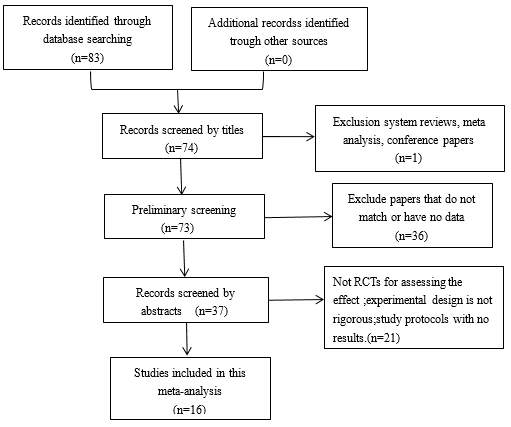
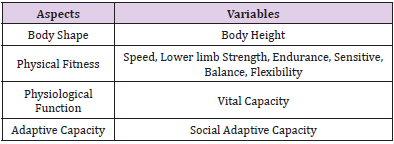
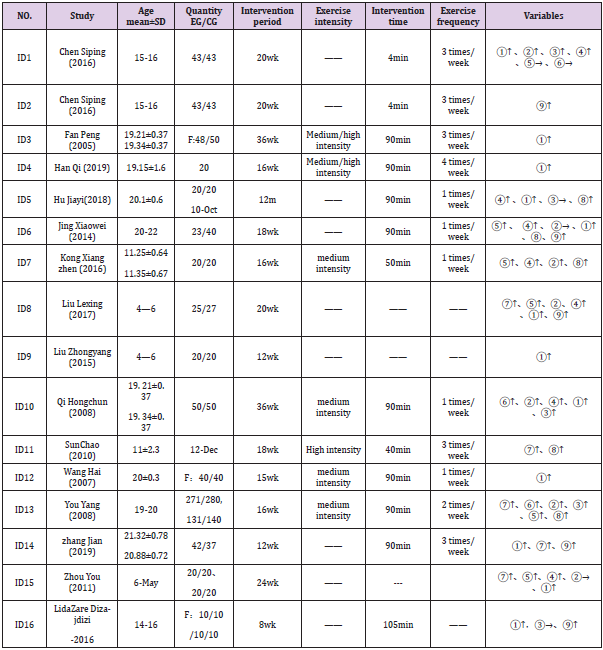
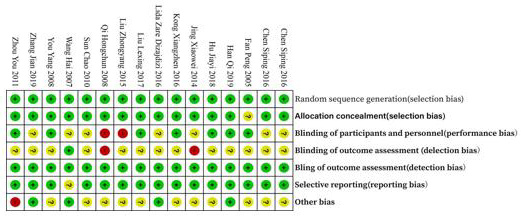
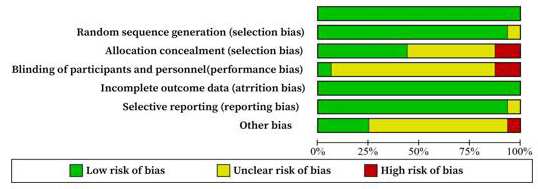
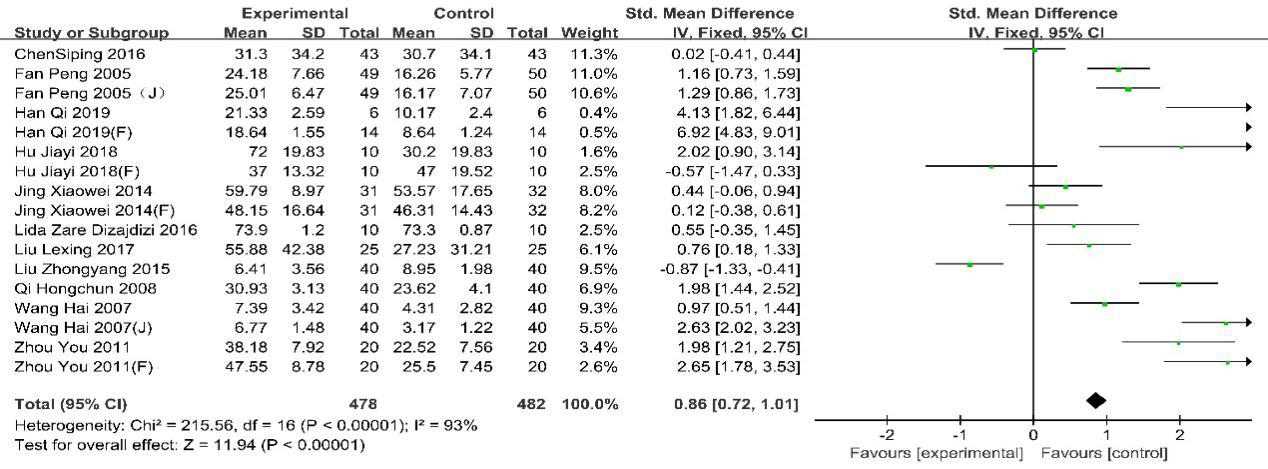










No comments:
Post a Comment
Note: Only a member of this blog may post a comment.